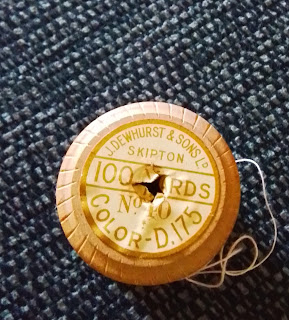Skipton 2000 The Millennium Walk
Extracts from the book 'Skipton 2000 The Millennium Walk' compiled by Ian Lockwood. Published by The Skipton Millennium Task Force in 1999. These are the pieces pertinent to research into Dewhursts.
P61:
For more than a century textiles were Skipton 's major employer but when cheaper foreign imports came to flood the market it's decline was rapid. It took barely 20 years, from the 1960s to the 1980s for textiles to go from chief employer to virtually non-existant.
Dewhurst's Mill still dominates the town but it's textile days are now long gone. As late as the 1970s Dewhurst's famous "Sew it With Sylko" slogan was a familiar sight in households and wooden bobbins with cotton thread in all sorts of colours were a feature of households across the land. The slogan was written in huge letters across a walkway above Broughton Road which connected the mill with its store sheds on the opposite side of the road.
The mill was opened by a cotton spinner operating in the vicinity of Skipton, John Dewhurst, in 1832 producing worsted yarns on land bought from the heirs of William Chamberlain, a merchant who owned extensive land on the west side of the town. Dewhurst was to show the vision which was to single out his firm as the leading manufacturer in the town by being the first to introduce power looms in 1829, although Dawson notes that he took the precaution of bringing them in with absolute secrecy and securely boxed up so that most would not know what was in the crates. In 1831 the mill burned down - possibly as a result of arson - but was rebuilt and operating again within six months. Further trouble was to visit Mr Dewhurst again in 1842 with a visit of rioters protesting against new technology putting them out of jobs.
However the firm prospered and the Craven Herald of December 1854 was able to report on the addition of 385 looms. A special celebration was held at the Craven Hotel for all the workers but John Dewhurst was prevented by illness from attending, the business now being under control of his son, John Bonny Dewhurst.
P62:
A new and large mill was built, occupying five storeys, on Broughton Road in 1870. The entire premises occupied 20,000 square yards and between 800 and 900 people worked there.
P63:
The Dewhursts were for many years the largest single employer in the town. John Bonny Dewhurst and his family moved into Aireville Park and lived the life of magnates....The firm continued to be a symbol of Skipton 's wealth and it came as something of a shock, despite the obvious decline of the British textile industry, when the English Sewing Company announced in February 1983 the closure of its Skipton operations in August of that year. When the mill closed the premises were taken over by Kingsley Cards. In 1993 the old mill chimney, a major landmark in the town, was demolished.
P74 - 77:
Notes on the Plug Drawing Riots, 1842:
The introduction of power loom machinery was a source of great alarm. The Plug Drawing Riots were so called because the agitators would pull the plug from the bottom of boilers, let out the water and extinguish the fire of the power looms. But rioters also had another agenda: they were desperately hungry for food and the riots were often as much about looting to feed families.
16th August 1842. A large body of men and women, four abreast, marching up Broughton Road towards Dewhurst's Mill armed with sticks. The number was put at 3,000...they went to the mills and pulled out the boiler plugs and halted the mills.
The Riot Act was read in the Market Place and the military were brought in. The soldiers charged at the mob with bayonets, dispersing them in all directions. The military stayed until they were called to another disturbance at Colne. 6 men were apprehended and sent to trial at York Assizes. They were sentenced to imprisonment with hard labour.




Comments
Post a Comment